Sustainable Affordability
Jun. 13, 2019
I am grateful for the various suggestions alumni and current students have submitted for how Wesleyan might offer a greater percentage of its revenue for scholarships. There is a fairly straightforward equation: the more we spend on providing access to the university, the less there is to spend on providing the education to which students want access. Yes, there are certain things we can do to increase revenue: we can charge (those who pay) more; we can spend more of our fundraised dollars (rather than putting the money in the endowment); we can increase spending from the endowment. We can also start new programs or enterprises that will subsidize the university’s core programs. We have considered the first group of alternatives, and we don’t think they are sustainable. We are also considering possibilities for ventures that might subsidize our core operations, but none of these have yet convinced us they will be successful, and like all such ventures they entail some financial risk.
Here’s a general snapshot of our 2012 operating expenses.
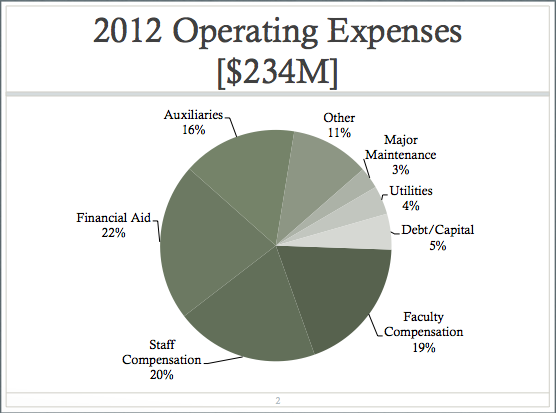
The slices of the pie we can readily affect with policy changes are financial aid, staff compensation and faculty compensation. For example, in the aftermath of the financial crisis we reduced the size of the staff by 11%. Faculty and staff compensation also took a hit, with a pay freeze and reduced increases. We do, however, in the long run aim to be in the middle of our peer group regarding faculty compensation. We could also reduce the number of faculty, of course, but that would mean increasing the size of classes or further limiting access. We have stopped about $200 million dollars in capital expenses for new projects, but it would be wrong to undermine the beauty of our campus by shortchanging major maintenance.
This next illustration shows the sources of our revenue in 2005 and 2012.
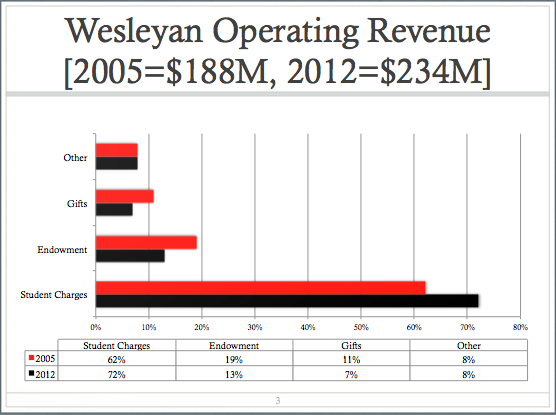
The most important thing to notice here is the university’s increased dependence on student charges. Although our endowment in 2012 is roughly the same size as in 2005 (due to the brutal market downturn in 2008), we are spending less from it in support of a larger budget. Throughout the first decade of the 2000s (at least), our endowment spending was too high. It was eating away at our economic foundation. Notice, too, that the percentage of gifts supporting the budget is smaller in 2012. We are raising more money than ever now, but we have decided to put a much greater percentage of the funds we raise into the endowment. In this way, we believe we will put a secure foundation under our scholarship and academic programs. But there is less to spend now.
The next two charts show how undergraduate financial aid has become a much more significant percentage of the budget directly tied to our mission. In less than 15 years the percentage of the core operating budget devoted to financial aid has almost doubled – from 15% to 29%. Another way of looking at this is to show the growth of the “discount rate.” Discount rate refers to the percentage of tuition revenue that is not being collected. Since 1997 this has grown from 22% to 37%. Both of these measures indicate that there is less to spend on the education for which we are giving students financial aid.
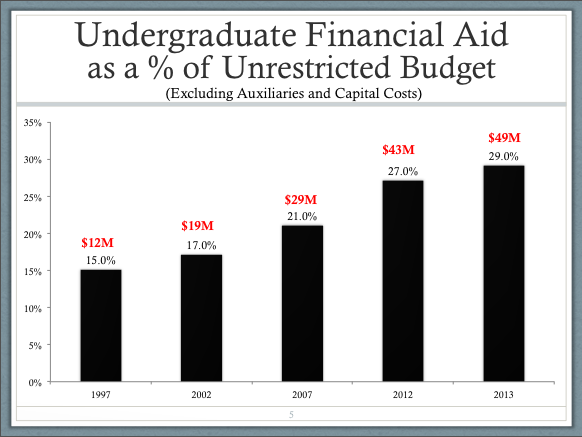
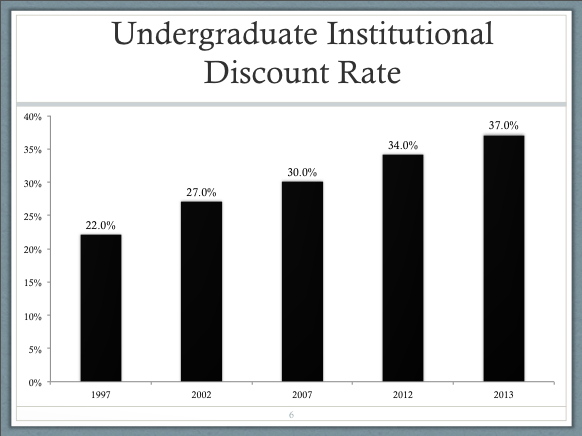
For years, Wesleyan supported these budget developments by borrowing, taking money out of the endowment (or not putting money in), and by increasing tuition well beyond the rate of inflation. In the last four years we have brought endowment spending down, and we are putting a much greater percentage of the gifts we receive into the endowment. Alas, we have also continued to increase tuition aggressively, as the final slide shows.
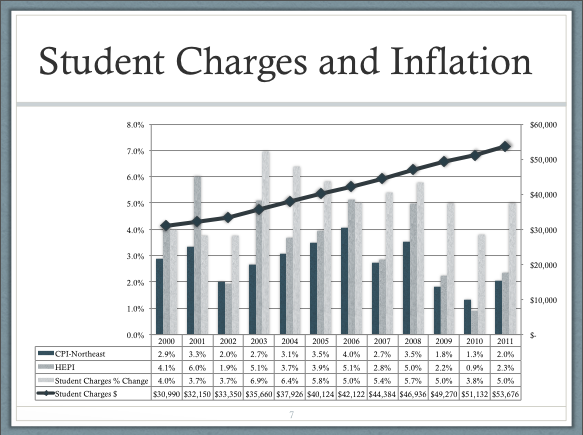
For this coming year, we have increased tuition and fees 4.5%, putting us even higher on the list of America’s most expensive schools. But going forward, even continued tuition hikes like this would not be enough to compensate for continued increases in the discount rate. Next year, for example, our financial aid budget will increase 15%.
It is for these reasons that we have introduced three guidelines for sustainable affordability. We will link tuition increases to the rate of inflation, and over time this should bring us out of the ranks of the most expensive universities. We will make the 3-year option more visible for students who want to graduate in 6 semesters plus summer work. This would save families around $50,000 from their total tuition bill without changing the core academic experience. We will manage a financial aid budget so that our discount rate is around 30%, roughly the rate of financial aid distributed in 2007. This would allow us to maintain a diverse student body, while also having the revenue to fund programs that have attracted these students to Wesleyan in the first place.
In a recent Roth on Wesleyan blog, the most controversial step I described was being only as “need-blind” as we can afford to be. Some people believe (mistakenly, I think) that being “need-blind” is a sign of purity. As I’ve said before, we could be “need-blind” and spend less money on scholarships. It’s easy for schools to choose metrics of student quality (like SAT scores) that correlate with wealth. They can say they are “need-blind” while having a wealthier and more homogeneous student body. Schools can also remain “need-blind” by increasing loan levels or expected parental contribution. We have done this in the past. We will not do this now.
We will continue to discuss these plans with students, faculty, staff and alumni. We will read all applications in a need-blind mode. Only toward the conclusion of the admission cycle (when we have a sense of likely financial aid expenditures) will we determine whether we should consider ability to pay for the last group of students admitted. There may be ways to cut the budget so as to allow for even more financial aid. As you may imagine, we have already scoured the spreadsheets looking for opportunities to save money – and we will continue to do so. We have gotten suggestions from students and alumni who want to protect some things and cut others. Do we eliminate programs? Reduce our real estate portfolio to eliminate inefficient housing? Lay off large numbers of people? Abandon the scholar-teacher model? Thus far we have concluded that such changes would have a much greater negative impact on a Wesleyan education than anything we have proposed.
As I said in my blog: Wesleyan will continue to seek a diverse student body, continue to meet full need, and continue to hold down student debt. We will continue actively to seek students who have great academic potential and very high need — families whose incomes make them eligible for our no-loan program, students who will receive full scholarships. Rather than being merely need-blind, we will aggressively seek out students without economic resources who have enormous talent. We do this through Questbridge and through dozens of connections with community-based organizations. We will also strive to find ways to make Wesleyan more affordable to middle class students by reducing our dependence on steep tuition hikes and by making our 3-year option more visible.
Wesleyan will remain an institution that values diversity and become one that pays attention to sustainability. Together, we will energize a progressive liberal arts institution that serves its students well and does its supporters proud.
